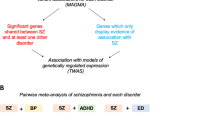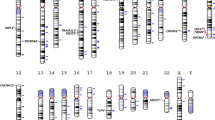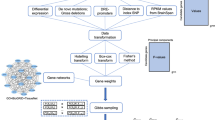Abstract
Genome-wide association (GWAS) analyses have identified susceptibility loci for many diseases, but most risk for any complex disorder remains unattributed. There is therefore scope for complementary approaches to these data sets. Gene-wide approaches potentially offer additional insights. They might identify association to genes through multiple signals. Also, by providing support for genes rather than single nucleotide polymorphisms (SNPs), they offer an additional opportunity to compare the results across data sets. We have undertaken gene-wide analysis of two GWAS data sets: schizophrenia and bipolar disorder. We performed two forms of analysis, one based on the smallest P-value per gene, the other on a truncated product of P method. For each data set and at a range of statistical thresholds, we observed significantly more SNPs within genes (Pmin for excess<0.001) showing evidence for association than expected whereas this was not true for extragenic SNPs (Pmin for excess>0.1). At a range of thresholds of significance, we also observed substantially more associated genes than expected (Pmin for excess in schizophrenia=1.8 × 10−8, in bipolar=2.4 × 10−6). Moreover, an excess of genes showed evidence for association across disorders. Among those genes surpassing thresholds highly enriched for true association, we observed evidence for association to genes reported in other GWAS data sets (CACNA1C) or to closely related family members of those genes including CSF2RB, CACNA1B and DGKI. Our analyses show that association signals are enriched in and around genes, large numbers of genes contribute to both disorders and gene-wide analyses offer useful complementary approaches to more standard methods.
This is a preview of subscription content, access via your institution
Access options
Subscribe to this journal
Receive 12 print issues and online access
$259.00 per year
only $21.58 per issue
Buy this article
- Purchase on Springer Link
- Instant access to full article PDF
Prices may be subject to local taxes which are calculated during checkout

Similar content being viewed by others
References
Manolio TA, Brooks LD, Collins FS . A HapMap harvest of insights into the genetics of common disease. J Clin Invest 2008; 118: 1590–1605.
Zeggini E, Scott LJ, Saxena R, Voight BF, Marchini JL, Hu T et al. Meta-analysis of genome-wide association data and large-scale replication identifies additional susceptibility loci for type 2 diabetes. Nat Genet 2008; 40: 638–645.
Wellcome Trust Case Control Consortium. Genome-wide association study of 14 000 cases of seven common diseases and 3000 shared controls. Nature 2007; 447: 661–678.
Mathew CG . New links to the pathogenesis of Crohn disease provided by genome-wide association scans. Nat Genet 2008; 9: 10–14.
Neale BM, Sham PC . The future of association studies: gene-based analysis and replication. Am J Hum Genet 2004; 75: 353–362.
Ioannidis JP . Non-replication and inconsistency in the genome-wide association setting. Hum Hered 2007; 64: 203–213.
Terwilliger JD, Hiekkalinna T . An utter refutation of the Fundamental Theorem of the HapMap. Eur J Hum Genet 2006; 14: 426–437.
Moskvina V, O'Donovan MC . Detailed analysis of the relative power of direct and indirect association studies and the implications for their interpretation. Hum Hered 2007; 64: 63–73.
Risch N . Linkage strategies for genetically complex traits I: multilocus models. Am J Hum Genet 1990; 46: 222–228.
Craddock N, Khodel V, Van Eerdewegh P, Reich T . Mathematical limits of multilocus models: the genetic transmission of bipolar disorder. Am J Hum Genet 1995; 57: 690–702.
Lewis CM, Levinson DF, Wise LH, DeLisi LE, Straub RE, Hovatta I et al. Genomescan meta-analysis of schizophrenia and bipolar disorder, partII: schizophrenia. Am J Hum Genet 2003; 73: 34–48.
Segurado R, Detera-Wadleigh SD, Levinson DF, Lewis CM, Gill M, Nurnberger Jr JI et al. Genome scan meta-analysis of schizophrenia and bipolar disorder, part III: bipolar disorder. Am J Hum Genet 2003; 73: 49–62.
Walsh T, McClellan JM, McCarthy SE, Addington AM, Pierce SB, Cooper GM et al. Rare structural variants disrupt multiple genes in neurodevelopmental pathways in schizophrenia. Science 2008; 320: 539–543.
The International Schizophrenia Consortium. Rare chromosomal deletions and duplications increase risk of schizophrenia. Nature 2008; 455: 237–241.
Stefansson H, Rujescu D, Cichon S, Pietiläinen OP, Ingason A, Steinberg S et al. Large recurrent microdeletions associated with schizophrenia. Nature 2008; 455: 232–236.
Xu B, Roos JL, Levy S, van Rensburg EJ, Gogos JA, Karayiorgou M . Strong association of de novo copy number mutations with sporadic schizophrenia. Nat Genet 2008; 40: 880–885.
Dudbridge F, Gusnanto A . Estimation of significance thresholds for genomewide association scans. Genet Epidemiol 2008; 32: 227–234.
Baum AE, Akula N, Cabanero M, Cardona I, Corona W, Klemens B et al. A genome-wide association study implicates diacylglycerol kinase eta (DGKH) and several other genes in the etiology of bipolar disorder. Mol Psychiatry 2008; 13: 197–207.
Ferreira MAR, O'Donovan MC, Meng YA, Jones IR, Ruderfer DM, Jones L et al. Collaborative genome-wide association analysis of 10 596 individuals supports a role for Ankyrin-G (ANK3) and the alpha-1C subunit of the L-type voltage gated calcium channel (CACNA1C) in bipolar disorder. Nat Genet 2008; 40: 1056–1058.
O'Donovan MC, Craddock N, Norton N, Williams H, Peirce T, Moskvina V et al. Identification of loci associated with schizophrenia by genome-wide association and follow-up. Nat Genet 2008; 40: 1053–1055.
Craddock N, O'Donovan MC, Owen MJ . The genetics of schizophrenia and bipolar disorder: dissecting psychosis. J Med Genet 2005; 42: 193–204.
Devlin B, Roeder K . Genomic control for association studies. Biometrics 1999; 55: 997–1004.
Zaykin DV, Zhivotovsky LA, Westfall PH, Weir BS . Truncated product method for combining P-values. Genet Epidemiol 2002; 22: 170–185.
Gottesman II, Shields J . A polygenic theory of schizophrenia. Proc Natl Acad Sci USA 1967; 58: 199–205.
O'Rourke DH, Gottesman II, Suarez BK, Rice J, Reich T . Refutation of the general single-locus model for the etiology of schizophrenia. Am J Hum Genet 1982; 34: 630–649.
Crow TJ . The emperors of the schizophrenia polygene have no clothes. Psychol Med 2008; 21: 1–5.
Craddock N, O'Donovan MC, Owen MJ . Genome-wide association studies in psychiatry: lessons from early studies of non-psychiatric and psychiatric phenotypes. Mol Psychiatry 2008; 13: 649–653.
Lencz T, Morgan TV, Athanasiou M, Dain B, Reed CR, Kane JM et al. Converging evidence for a pseudoautosomal cytokine receptor gene locus in schizophrenia. Mol Psychiatry 2007; 12: 572–580.
Chen Q, Wang X, O'Neill FA, Walsh D, Fanous A, Kendler KS et al. Association study of CSF2RB with schizophrenia in Irish family and case - control samples. Mol Psychiatry 2008; 13: 930–938.
Hanson DR, Gottesman II . Theories of schizophrenia: a genetic-inflammatory-vascular synthesis. BMC Med Genet 2005; 6: 7.
Acknowledgements
This study was supported by the Medical Research Council (UK) and by the Wellcome Trust. This study makes use of data generated by the Wellcome Trust Case Control Consortium. A full list of the investigators who contributed to the generation of the data is available from www.wtccc.org.uk. Funding for that project was provided by the Wellcome Trust under award 076113.
Author information
Authors and Affiliations
Consortia
Corresponding authors
Additional information
Web Resources
NCBI database NCBI (http://www.ncbi.nlm.nih.gov/).
NCBI's dbSNP database (http://www.ncbi.nlm.nih.gov/SNP/).
NCBI's Genome database (http://www.ncbi.nlm.nih.gov/sites/entrez?db=genome).
Supplementary Information accompanies the paper on the Molecular Psychiatry website (http://www.nature.com/mp)
Supplementary information
Rights and permissions
About this article
Cite this article
Moskvina, V., Craddock, N., Holmans, P. et al. Gene-wide analyses of genome-wide association data sets: evidence for multiple common risk alleles for schizophrenia and bipolar disorder and for overlap in genetic risk. Mol Psychiatry 14, 252–260 (2009). https://doi.org/10.1038/mp.2008.133
Received:
Revised:
Accepted:
Published:
Issue Date:
DOI: https://doi.org/10.1038/mp.2008.133
Keywords
This article is cited by
-
Progress and Implications from Genetic Studies of Bipolar Disorder
Neuroscience Bulletin (2024)
-
Similarities and differences between multivariate patterns of cognitive and socio-cognitive deficits in schizophrenia, bipolar disorder and related risk
Schizophrenia (2023)
-
Transmembrane protein 108 inhibits the proliferation and myelination of oligodendrocyte lineage cells in the corpus callosum
Molecular Brain (2022)
-
Roles and mechanisms of ankyrin-G in neuropsychiatric disorders
Experimental & Molecular Medicine (2022)
-
A human iPSC-astroglia neurodevelopmental model reveals divergent transcriptomic patterns in schizophrenia
Translational Psychiatry (2021)



